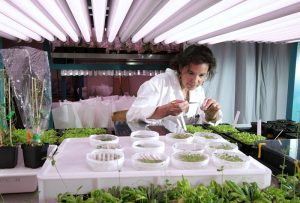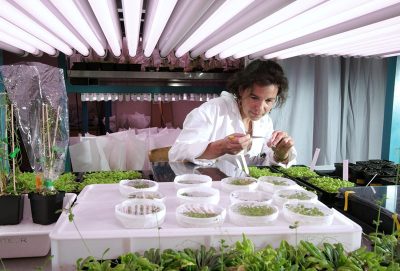Adaptation: responding to environmental challenges
PDF
Since Jean-Baptiste de Lamarck and Charles Darwin, we know that living beings were not created once and for all by a divine force to constitute a harmonious nature. The harmony of nature is only a matter of the imagination and every living species must constantly respond to the challenges imposed by the environment, both biotic and abiotic. Life has only been able to proliferate and diversify on Earth by developing adaptive capacities. They allow it to adapt to an often hostile environment, in any case always changing, either seasonally or over the long term. These adaptations cover all their biological characteristics, from physiology to morphology and ethology. They concern all levels of life organization, from the individual level to the population level.
1. Adaptations at the individual level
Physiological adaptation commonly refers to changes at the individual level. An individual’s metabolism changes temporarily, by regulating gene expression, in response to external conditions. Such coping mechanisms are essential for life and reproduction. The selection pressure for their development has certainly been very strong. There are many examples of this in all types of living organisms.
In the animal kingdom, let us mention two of the most famous. In humans, exposure to sunlight, especially ultraviolet rays, leads to the synthesis of a black pigment, melanin, which stops these rays and protects the skin from their mutagenic effects (see Cellular impact of solar UV). In all terrestrial mammals, the coat varies in density according to the seasons, and allows adaptation to seasonal temperature differences.

For plants living in arid regions, even more drastic adaptations of their own morphology were required (see the example of cactoid plants in the text Inheritance or convergence?) or the example presented at the beginning of this article by Welwitschia mirabilis, an endemic plant in the Namib Desert in southern Africa. But this is a second level of adaptation: that of the populations.
2. Population-level adaptations
Hereditary changes promote the adaptation of a population to a constantly changing environment and lead, in the long term, to the evolution of species. The living world has thus acquired mechanisms that allow it to be more and more autonomous from the environment: for example, homeothermicThe characteristic of animal species (birds, mammals) whose internal environment (blood and lymph) maintains a constant temperature, regardless of the temperature of the external environment, within very wide limits. animals or the ability to store water. Our species has even acquired the ability to modify the environment itself. It was on the mechanism of these evolutionary adaptations that Lamarck and Darwin’s theories radically diverged. The first explained biological evolution – “transformationism” at the time – by a direct and inheritable effect of the environment on individuals (see Theory of Evolution: misunderstanding and resistance and Lamarck and Darwin: two divergent visions of the living world). Darwin explained it by selecting, from random genetic variation – the “descent with modifications” – individuals capable of leaving the most descendants in a given environment. His theory has been verified by more than a century of research. This “Darwinian process” promotes genotypesInformation carried by the genome of an organism, contained in each cell in the form of deoxyribonucleic acid (DNA). In the DNA molecule, it is the sequence of nucleotides that constitutes the genetic information. that are most adapted to the environment and results, over generations, in the modification of species.

3. Epigenetic memory
A third level of adaptation falls between the two previous levels. Like the first level, it is individual and plays only on the regulation of gene expression, without intervention on their structure. But this third level involves a transient hereditary transmission of these regulations. This allows descendants, over a few generations, to benefit from the adaptive response of their parents. This is referred to as epigenetic memory or transgenerational effect (see Epigenetics, the genome and its environment). This type of phenomenon has been known for a long time, but it has remained relatively exceptional. The first known cases mainly concerned paramecia, unicellular eukaryotesUnicellular or multicellular organisms whose cells have a nucleus and organelles (endoplasmic reticulum, Golgi apparatus, various plasters, mitochondria, etc.) delimited by membranes. Eukaryotes are, along with bacteria and archaea, one of the three groups of the living organism. . Since 2000, examples have multiplied and cover a wide range of characters. They have often been observed in response to environmental stresses, but also in the case of maternal behaviours in rats [2].

About this epigenetic memory, some popularization authors and even some scientists speak of a return to lamarckismMovement related to Lamarck’s ideas. Often reduced to the idea of the transmission of acquired traits, although Jean-Baptiste Lamarck’s transformist theory is much broader than that. (or even to lyssenkoismMovement relating to Lyssenko’s ideas which led to the establishment in the USSR of a policy of genetic and agricultural control. Nowadays, Lyssenkism is regularly used metaphorically to denounce the manipulation or distortion of the scientific method to support a pre-determined conclusion, often linked to a social or political objective.!). This is inappropriate because epigenetic changes are reversible, they can only allow temporary adaptation to stress. Not based on DNA sequences changes, they do not modify the genetic structure of the lineage concerned and a process of speciationEvolutionary process leading to the emergence of new living species that individualize from populations belonging to an original species. is therefore excluded. However, although there are only few studies on this subject, we may imagine that this type of transgenerational memory is complementary to the Darwinian process. It will allow individuals under environmental stress to survive and reproduce by transmitting protection to their descendants. If the stress disappears, the response fades and the population returns to its previous life; if it persists, this response allows the population to maintain itself and gives it time to adapt through the Darwinian process. The fact that genome variation mechanisms are stimulated for a few generations will facilitate this adaptation by increasing genetic variability.
References and notes
Cover image. Welwitschia mirabilis, a unique plant of the Namib Desert tSource: Petr Kosina via Visual hunt (CC BY-NC 2.0)]
[1] Leonardi M, Gerbault P, Thomas MG & Burger J (2012) The evolution of lactase persistence in Europe. A synthesis of archaeological and genetic evidence. J. Int. Dairy J. 22:88-97
[2] Zhang TY et al (2013) Epigenetic mechanisms for the early environmental regulation of hippocampal glucocorticoid receptor gene expression in rodents and humans. Neuropsychopharmacology. 38) :111-123
[3] Laurençon A et al (1998) Genetic variations and their regulation: the fruit fly has a lot to teach us. Med/Sci. No. 11, vol. 14, Nov. 98. See also: Science in the Present, 2000. Editions Enclyclopædia Universalis, p.148-152
[4] Molinier J et al (2006) Trangenerational memory of stress in plants. Nature 442:1046-1049
[5] Boyko A, Kovalchuk I. (2011) Genome instability and epigenetic modification-heritable responses to environmental stress? Curr Opin Opin Plant Biol 14:260-266
The Encyclopedia of the Environment by the Association des Encyclopédies de l'Environnement et de l'Énergie (www.a3e.fr), contractually linked to the University of Grenoble Alpes and Grenoble INP, and sponsored by the French Academy of Sciences.
To cite this article: BREGLIANO Jean-Claude (April 15, 2019), Adaptation: responding to environmental challenges, Encyclopedia of the Environment, Accessed July 27, 2024 [online ISSN 2555-0950] url : https://www.encyclopedie-environnement.org/en/life/adaptation-responding-to-environmental-challenges/.
The articles in the Encyclopedia of the Environment are made available under the terms of the Creative Commons BY-NC-SA license, which authorizes reproduction subject to: citing the source, not making commercial use of them, sharing identical initial conditions, reproducing at each reuse or distribution the mention of this Creative Commons BY-NC-SA license.












